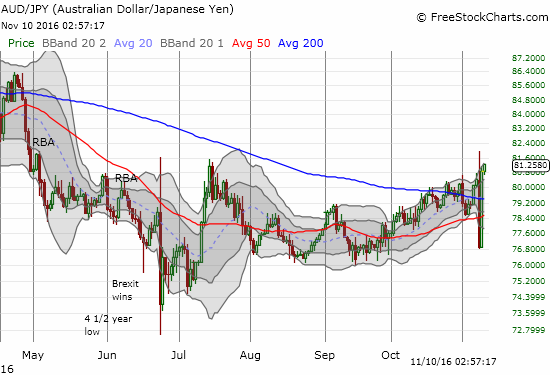In my last post, I wrote about the small solace I took in profits on my short AUD/JPY position as the Japanese yen (FXY) surged in response to a looming victory by Donald Trump for the U.S. Presidency. At the time, I closed out the position assuming that currency bearishness was over-extended by quick-trigger negative sentiment. The trade was timely as AUD/JPY soared soon after.

AUD/JPY reverses from a bearish breakdown and back to a VERY bullish breakout.
The return to a bullish breakout definitively confirmed the simultaneous rally in financial markets and kept me confident in my market bullishness through the entire wild election trading.
However, the wild and wide-ranging reaction in the U.S. dollar completely startled me. I went from thinking that the profits in AUD/JPY helped fund my U.S. dollar losses to celebrating a whopper of a rally in my long U.S. dollar positions. The U.S. dollar sank rapidly as financial markets began to process a likely Donald Trump victory. Right before or shortly after the victory was a done deal, the dollar promptly reversed its losses. By the close of U.S. markets, the dollar managed a net GAIN of 0.7%. I use EUR/USD to break down the overnight trading action.

The U.S. dollar index (DXY0) ended its first post-election day with a 0.7% gain, but it is still short of the most recent high.

This 15-minute chart shows how the U.S. dollar first rapidly retreated against the euro and then gained almost as fast. The dust settled with a net loss for EUR/USD.

The daily chart shows how the post-election wild ride for EUR/USD mirrors the immediate reaction to Brexit back in June.
I think these moves demonstrated massive confusion in the currency market on the implications of a Trump presidency. One could argue numerous pros and cons that can loop you around and around. I will assume that the argument that prevailed in the end is that Trump’s displeasure with the low interest rate environment in America has all but guaranteed that the Federal Reserve will feel the heat to finally end its dithering and hike rates at its December meeting. The chart below shows how the odds of a rate hike have risen since the jobs report for October. The election pushed the odds of a December rate hike from 76.3% to 81.1%.

